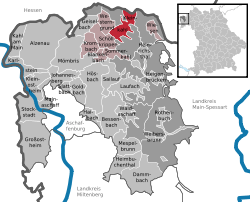Kleinkahl
| Kleinkahl | ||
|---|---|---|
| ||
 Kleinkahl | ||
Location of Kleinkahl within Aschaffenburg district  | ||
| Coordinates: 50°7′N 9°16′E / 50.117°N 9.267°ECoordinates: 50°7′N 9°16′E / 50.117°N 9.267°E | ||
| Country | Germany | |
| State | Bavaria | |
| Admin. region | Unterfranken | |
| District | Aschaffenburg | |
| Municipal assoc. | Schöllkrippen | |
| Subdivisions | 5 Ortsteile | |
| Government | ||
| • Mayor | Angelika Krebs | |
| Area | ||
| • Total | 11.86 km2 (4.58 sq mi) | |
| Elevation | 242 m (794 ft) | |
| Population (2012-12-31)[1] | ||
| • Total | 1,821 | |
| • Density | 150/km2 (400/sq mi) | |
| Time zone | CET/CEST (UTC+1/+2) | |
| Postal codes | 63828 | |
| Dialling codes | 06024 | |
| Vehicle registration | AB | |
| Website | www.gemeinde-kleinkahl.de | |
Kleinkahl is a community in the Aschaffenburg district in the Regierungsbezirk of Lower Franconia (Unterfranken) in Bavaria, Germany, and a member of the Verwaltungsgemeinschaft (Administrative Community) of Schöllkrippen.
Geography
Location

Kleinkahl lies in the Bavarian Lower Main (Bayerischer Untermain).
The community has the following Gemarkungen (traditional rural cadastral areas): Edelbach, Großkahl, Großlaudenbach, Kleinkahl, Kleinlaudenbach, Bamberger Mühle.
History
Part of the current municipal area lay within the Archbishopric of Mainz and in 1803, on orders given by the Archchancellor of Dalberg, it was secularized. The rest lay within Krombach over which the Counts of Schönborn held sway and passed with mediatization in 1806 to the Principality of Aschaffenburg, with which it passed in 1814 to Bavaria. In the course of administrative reform in Bavaria, the current community came into being with the Gemeindeedikt (“Municipal Edict”) of 1818.
Population development
Within the municipal area, there were 1,608 inhabitants in 1970, 1,582 in 1987 and 1,842 in 2000.
Politics
Community council
The council is made up of 13 council members, counting the part-time mayor.
| CSU/Wählergemeinschaft | Total | |
| 2002 | 13 | 13 seats |
(as at municipal election held on 3 March 2008)
Coat of arms
The community’s arms might be described thus: A pallet wavy per pallet wavy argent and azure, dexter gules a glass of the last, sinister a castle with three towers embattled gules.
The parted wavy pallet refers to the community’s geographical location of the river Kahl, which runs through the community. Since municipal reform in 1970 the community has been made up of five constituent communities, Kleinkahl and Kleinlaudenbach on the Kahl’s left bank, and Großkahl and Großlaudenbach on the Kahl’s right bank. Edelbach lies somewhat farther away. The river, which rises some two or three kilometres upstream, was in the Middle Ages a political boundary. The glass on the dexter (armsbearer’s right, viewer’s left) side is a so-called Spechter and refers to the local glass production since the Middle Ages. The tinctures argent and gules (silver and red) are those of Electoral Mainz, to which the area belonged until 1803. The sinister (armsbearer’s left, viewer’s right) side shows the arms borne by the family Ulner of Dieburg, an aristocratic family known to have been in the municipal area from the 15th to the 17th century. The Ulner coat of arms was incorporated into the community’s arms not only for this family's history here, but rather also to recall the Counts of Rieneck and Schönberg.
The arms have been borne since 18 October 1985.
Mayor
The mayor is Angelika Krebs (Wählergemeinschaft).
Youth organizations
Junge Union
The Kleinkahl Junge Union was founded in March 2008 and with 25 members is one of the biggest local chapters in the Aschaffenburg district. The chairman is 17-year-old Maximilian Markert.
Economy and infrastructure
Municipal tax revenue in 1999 amounted to €674,000 (converted), of which €8,000 (net) was business taxes.
According to official statistics, there were 160 workers on the social welfare contribution rolls working in producing businesses, and in trade and transport 0. In other areas, 27 workers on the social welfare contribution rolls are employed, and 667 such workers work from home. There are two processing businesses. Three businesses are in construction, and furthermore, in 1999, there were 28 agricultural operations with a working area of 563 ha, of which 162 ha was cropland and 399 ha was meadowland.
Education
The following institutions are on hand (as at 1999):
- Kindergartens: 75 kindergarten places with 55 children.
References
- ↑ "Fortschreibung des Bevölkerungsstandes". Bayerisches Landesamt für Statistik und Datenverarbeitung (in German). 31 December 2012.
External links
| Wikimedia Commons has media related to Kleinkahl. |
- This article incorporates information from the German Wikipedia.
